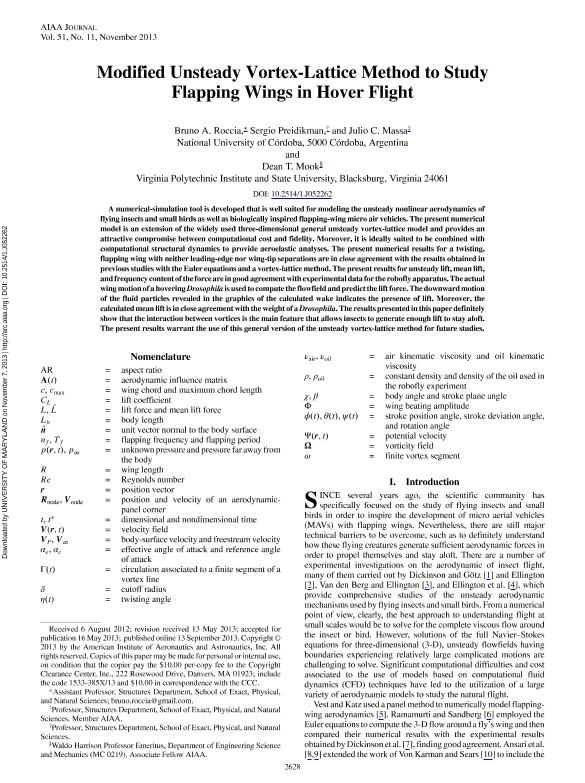Mostrar el registro sencillo del ítem
dc.contributor.author
Roccia, Bruno Antonio

dc.contributor.author
Preidikman, Sergio

dc.contributor.author
Massa, Julio Cesar

dc.contributor.author
Mook, Dean T.
dc.date.available
2017-09-19T18:31:45Z
dc.date.issued
2013-09
dc.identifier.citation
Roccia, Bruno Antonio; Preidikman, Sergio; Massa, Julio Cesar; Mook, Dean T.; Modified unsteady vortex-lattice method to study flapping wings in hover flight; Amer Inst Aeronaut Astronaut; Aiaa - American Institute Of Aeronautics And Astronautics; 51; 11; 9-2013; 2628-2642
dc.identifier.issn
0001-1452
dc.identifier.uri
http://hdl.handle.net/11336/24607
dc.description.abstract
A numerical-simulation tool is developed that is well suited for modeling the unsteady nonlinear aerodynamics of flying insects and small birds as well as biologically inspired flapping-wing micro air vehicles. The present numerical model is an extension of the widely used three-dimensional general unsteady vortex-lattice model and provides an attractive compromise between computational cost and fidelity. Moreover, it is ideally suited to be combined with computational structural dynamics to provide aeroelastic analyses. The present numerical results for a twisting, flapping wing with neither leading-edge nor wing-tip separations are in close agreement with the results obtained in previous studies with the Euler equations and a vortex-lattice method. The present results for unsteady lift, mean lift, and frequency content of the force are in good agreement with experimental data for the robofly apparatus. The actual wing motion of a hovering Drosophila is used to compute the flowfield and predict the lift force. The downward motion of the fluid particles revealed in the graphics of the calculated wake indicates the presence of lift. Moreover, the calculated mean lift is in close agreement with the weight of a Drosophila. The results presented in this paper definitely show that the interaction between vortices is the main feature that allows insects to generate enough lift to stay aloft. The present results warrant the use of this general version of the unsteady vortex-lattice method for future studies.
dc.format
application/pdf
dc.language.iso
eng
dc.publisher
Amer Inst Aeronaut Astronaut

dc.rights
info:eu-repo/semantics/openAccess
dc.rights.uri
https://creativecommons.org/licenses/by-nc-sa/2.5/ar/
dc.subject
Flapping Wings
dc.subject
Unsteady Aerodynamics
dc.subject
Nonlinear Aerodynamics
dc.subject
Vortex-Lattice Method
dc.subject.classification
Ingeniería Mecánica

dc.subject.classification
Ingeniería Mecánica

dc.subject.classification
INGENIERÍAS Y TECNOLOGÍAS

dc.title
Modified unsteady vortex-lattice method to study flapping wings in hover flight
dc.type
info:eu-repo/semantics/article
dc.type
info:ar-repo/semantics/artículo
dc.type
info:eu-repo/semantics/publishedVersion
dc.date.updated
2017-09-19T14:15:52Z
dc.identifier.eissn
1533-385X
dc.journal.volume
51
dc.journal.number
11
dc.journal.pagination
2628-2642
dc.journal.pais
Estados Unidos

dc.description.fil
Fil: Roccia, Bruno Antonio. Universidad Nacional de Córdoba; Argentina. Consejo Nacional de Investigaciones Científicas y Técnicas; Argentina
dc.description.fil
Fil: Preidikman, Sergio. Universidad Nacional de Córdoba; Argentina. Consejo Nacional de Investigaciones Científicas y Técnicas; Argentina
dc.description.fil
Fil: Massa, Julio Cesar. Universidad Nacional de Córdoba; Argentina
dc.description.fil
Fil: Mook, Dean T.. Virginia Polytechnic Institute; Estados Unidos
dc.journal.title
Aiaa - American Institute Of Aeronautics And Astronautics

dc.relation.alternativeid
info:eu-repo/semantics/altIdentifier/doi/http://dx.doi.org/10.2514/1.J052262
dc.relation.alternativeid
info:eu-repo/semantics/altIdentifier/url/https://arc.aiaa.org/doi/10.2514/1.J052262
Archivos asociados
